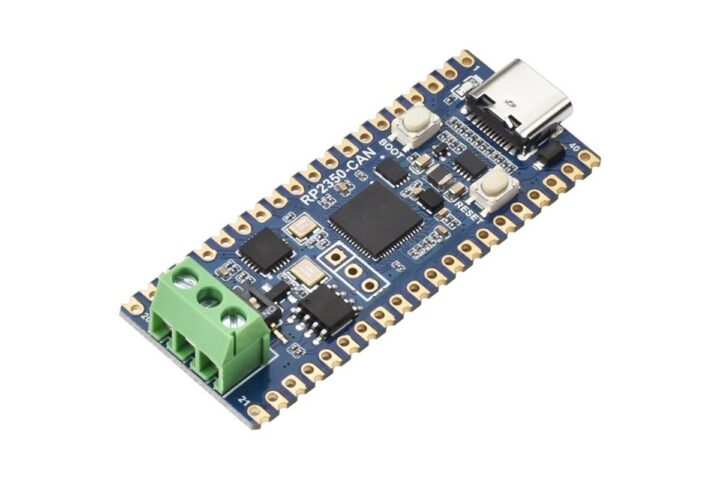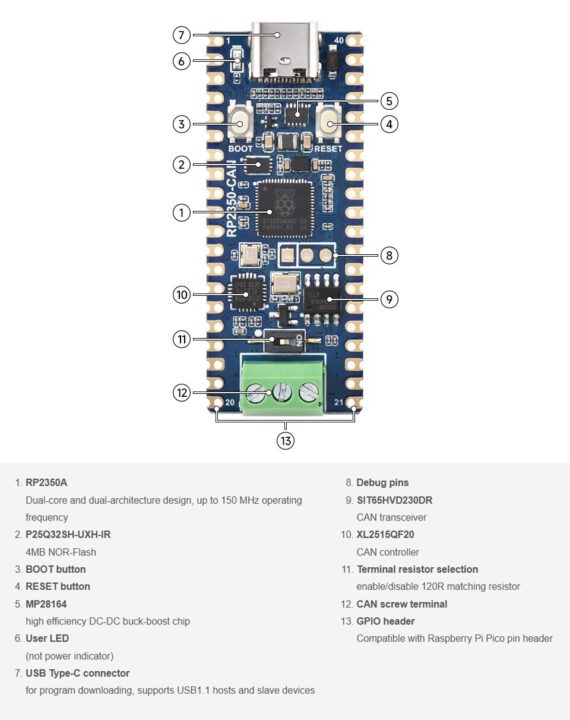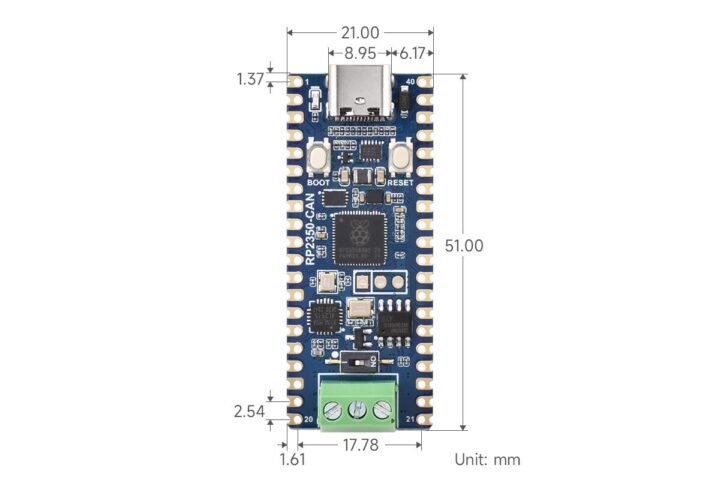Waveshare has recently launched RP2350-CAN, a Raspberry Pi RP2350-powered CAN development board with onboard XL2515 CAN Bus controller and a SIT65HVD230 CAN transceiver. The board supports the CAN V2.0B protocol at up to 1 Mbps, and the XL2515 chip appears to be a clone of the popular Microchip MCP2515 CAN controller.
The board includes the same 26 multi-function GPIO pins and USB-C port as found on the Raspberry Pi Pico 2. Other features include a DC-DC buck-boost converter (MP28164), BOOT and RESET buttons, a user LED, a selectable 120Ω CAN termination resistor, and CAN screw terminals. The CAN Bus board targets automotive, industrial control, and robotics applications.
Waveshare RP2350 CAN specifications:
- SoC – Raspberry Pi RP2350A
- CPU
- Dual-core Arm Cortex-M33 @ 150 MHz with Arm Trustzone, Secure boot OR
- Dual-core RISC-V Hazard3 @ 150 MHz
- Up to two cores can be used in any combination
- Memory – 520 KB on-chip SRAM
- Package – QFN-60
- CPU
- Storage – 4MB NOR Flash (P25Q32SH-UXH-IR)
- USB – USB Type-C 1.1 host/device connector for power and programming
- CAN Interface
- Xinluda XL2515 CAN controller
- SIT65HVD230 CAN transceiver
- Supports CAN V2.0B up to 1 Mbps
- Terminal resistor (120Ω) selection switch
- CAN screw terminal
- Expansion – 2x 20-pin headers
- 26x GPIO
- 2x UART
- 2x SPI controllers
- 2x I2C controllers
- 16x PWM channels
- 4x ADC
- 3x PIO blocks, 12x PIO (Programmable IO) state machines
- Debugging – SWD debug interface header
- Misc – Boot button, Reset button, user LED
- Power Supply – 1.8 to 5.5V with an onboard high-efficiency DC-DC converter (MP28164)
- Dimensions – 51 x 21 mm (Raspberry Pi Pico / Pico 2 form factor)
While checking the specifications, I noticed there is no power LED on the board, even though this board is not designed for low-power applications; that’s something to keep in mind.

In terms of software support, the board can be programmed with MicroPython, C/C++, and the Arduino IDE. If you’re into MicroPython, you can just flash the firmware using Thonny IDE and start coding right away. If you are using C/C++, there’s an official Pico extension for VSCode that makes building and uploading your projects simple. If you’re more comfortable with Arduino, you can use the Arduino-Pico core to program it just like any other Arduino board. More information to get started can be found on the wiki.
We previously covered a few MCU-based CAN bus boards like ESP32-based RejsaCAN-ESP32 and Autosport Labs ESP32-CAN-X2 board, as well as an Raspberry Pi RP2040-powered CANBed board. However, this is the first time we’ve come across a CAN Bus board with the Raspberry Pi RP2350. A few years ago, we also noted a software-based CAN Controller using the PIO on the RP2040 (and now RP2350). However, the implementation had some limitations at the time, so it’s unclear whether it can be used in practice.
The Waveshare RP2350 CAN development board can be purchased for $11.33 on AliExpress, $17.99 on Amazon, and $9.99 on Waveshare’s official store.
Debashis Das is a technical content writer and embedded engineer with over five years of experience in the industry. With expertise in Embedded C, PCB Design, and SEO optimization, he effectively blends difficult technical topics with clear communication
Support CNX Software! Donate via cryptocurrencies, become a Patron on Patreon, or purchase goods on Amazon or Aliexpress







